
The Old World flycatchers are a large family, the Muscicapidae, of small passerine birds restricted to the Old World, with the exception of several vagrants and two species, Bluethroat and Northern Wheatear, found also in North America. These are mainly small arboreal insectivores, many of which, as the name implies, take their prey on the wing. The family includes 344 species and is divided into 51 genera.
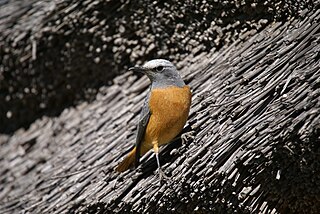
The rock thrushes, Monticola, are a genus of chats, medium-sized mostly insectivorous or omnivorous songbirds. All are Old World birds, and most are associated with mountainous regions.

The cochoas are medium-sized frugivorous, insectivorous and molluscivorous birds in the genus Cochoa. Their bright contrasting plumage patterns, sexual dimorphism and feeding habits made their systematic position difficult to ascertain in early times, Richard Bowdler Sharpe placed them with the Prionopidae in 1879 while many considered them as some kind of aberrant thrush. The genus was previously included in the Old World flycatcher family Muscicapidae but molecular phylogenetic studies have shown that it is more closely related to the thrush family Turdidae.

Brachypteryx is a genus of passerine birds containing six species known as shortwings, that occurs in southeast Asia.

The mountain wheatear or mountain chat is a small insectivorous passerine bird that is endemic to southwestern Africa.

Melaenornis is a genus of small passerine birds in the large family Muscicapidae commonly known as the Old World flycatchers. They are restricted to sub-Saharan Africa.
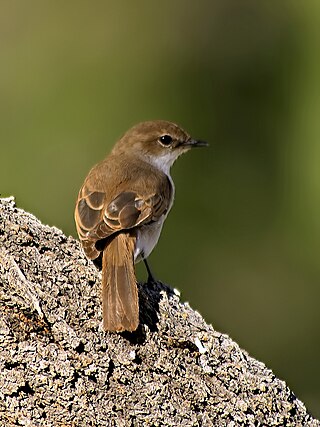
The Marico flycatcher or Mariqua flycatcher is a passerine bird in the Old World flycatcher family Muscicapidae that is found in areas of southern Africa.
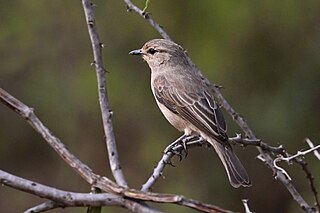
The African grey flycatcher, grayish flycatcher, or large flycatcher is a passerine bird in the Old World flycatcher family Muscicapidae that occurs in parts of East Africa.

The pale flycatcher is a passerine bird of the Old World flycatcher family Muscicapidae, found in Sub-Saharan Africa.
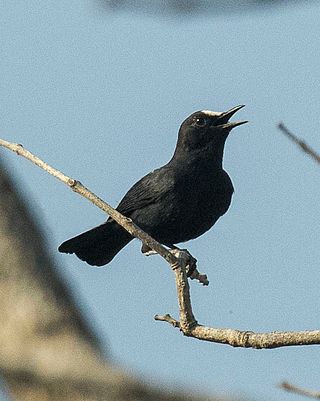
The white-fronted black chat is a species of passerine bird in the family Muscicapidae. It is found in Benin, Burkina Faso, Cameroon, Central African Republic, Chad, Democratic Republic of the Congo, Ivory Coast, Eritrea, Ethiopia, Gambia, Ghana, Guinea, Guinea-Bissau, Mali, Mauritania, Niger, Nigeria, Senegal, Sierra Leone, South Sudan, Togo, and Uganda. Its natural habitats are moist savanna and subtropical or tropical dry shrubland.

The brown-chested jungle flycatcher is a species of bird in the Old World flycatcher family Muscicapidae. It breeds in South China ; its winters in the Malay peninsula. Its natural habitats are subtropical or tropical moist lowland forests and subtropical or tropical mangrove forests. It is threatened by habitat loss.

The Sula jungle flycatcher is a species of passerine bird in the Old World flycatcher family Muscicapidae. It is endemic to Sula Island in Indonesia where its natural habitat is subtropical or tropical moist lowland forests. It is threatened by habitat loss.

The slaty-backed jungle flycatcher is a species of birds in the Old World flycatcher family Muscicapidae. It is endemic to the Philippines. The specific epithet honours the British zoological collector Walter Goodfellow. Its natural habitat is subtropical or tropical moist montane forests. It is becoming rare due to habitat loss.

The fulvous-chested jungle flycatcher is a species of bird in the Old World flycatcher family Muscicapidae. It is found in Brunei, Indonesia, Malaysia, Myanmar, and Thailand. Its natural habitat is subtropical or tropical moist lowland forests.

The Flores jungle flycatcher is a passerine bird in the Old World flycatcher family Muscicapidae that is endemic to the Lesser Sunda Islands.

The grey-chested jungle flycatcher is a species of bird in the Old World flycatcher family Muscicapidae. It is found in Brunei, Indonesia, Malaysia, and Thailand. Its natural habitats are subtropical or tropical moist lowland forests and subtropical or tropical swamps. It is threatened by habitat loss.
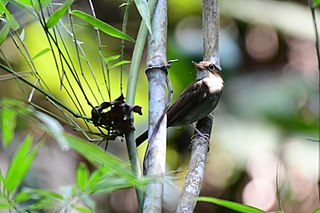
The Nicobar jungle flycatcher is a species of bird in the Old World flycatcher family Muscicapidae. It is endemic to the Nicobar Islands where its natural habitats are subtropical or tropical moist lowland forests and subtropical or tropical mangrove forests. It was at one time considered as a subspecies of the brown-chested jungle flycatcher.

Chamaetylas is a genus of small, mainly insectivorous birds in the Old World flycatcher family Muscicapidae that are native to sub-Saharan Africa.
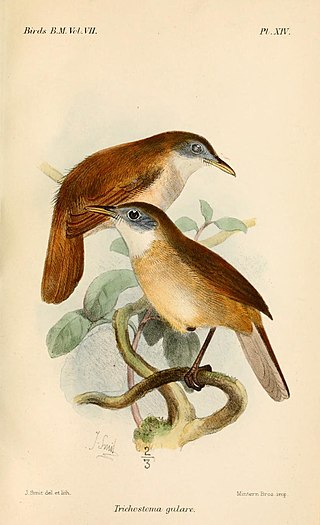
Vauriella is a genus of birds in the Old World flycatcher family Muscicapidae that occur in Borneo and the Philippines.

Emarginata is a genus of birds in the Old World flycatcher family Muscicapidae that occur in southern Africa.




















